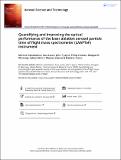| dc.contributor.author | Zawadowicz, Maria A | |
| dc.contributor.author | Lance, Sara | |
| dc.contributor.author | Jayne, John T | |
| dc.contributor.author | Croteau, Philip | |
| dc.contributor.author | Worsnop, Douglas R | |
| dc.contributor.author | Mahrt, Fabian | |
| dc.contributor.author | Leisner, Thomas | |
| dc.contributor.author | Cziczo, Daniel J | |
| dc.date.accessioned | 2025-10-24T14:30:33Z | |
| dc.date.available | 2025-10-24T14:30:33Z | |
| dc.date.issued | 2020-02-21 | |
| dc.identifier.uri | https://hdl.handle.net/1721.1/163381 | |
| dc.description.abstract | Single particle mass spectrometer (SPMS) instruments have been used for in-situ chemicalcharacterization of atmospheric aerosols, both in the field and laboratory, for over two deca-des. SPMSs typically combine precise optical particle sizing with laser desorption and ioniza-tion followed by time of flight mass spectrometry. Among the advantages of SPMSs overother aerosol chemistry measurement techniques are their single particle resolution andhigh sensitivity to trace chemical species. The AeroMegt Laser Ablation Aerosol ParticleTime of Flight Mass Spectrometer (LAAPToF) is a commercially available member of thisinstrument class, aiming for a compact size and simplicity for the end user. This articlequantifies the performance of LAAPToF with an emphasis on optical counting efficiency.Recommendations for improving detection compared to the base LAAPToF hardware aredescribed. Our results show that changes to the optical detection scheme can lead to overtwo orders of magnitude improvement in optical counting efficiency in the size range500–2000 nm vacuum aerodynamic diameter. We also present mass spectral performancefor characterizing atmospherically relevant particles in a comparison to a current SPMSdesign, the Particle Analysis by Laser Mass Spectrometry. | en_US |
| dc.language.iso | en | |
| dc.publisher | Taylor & Francis | en_US |
| dc.relation.isversionof | https://doi.org/10.1080/02786826.2020.1724867 | en_US |
| dc.rights | Creative Commons Attribution | en_US |
| dc.rights.uri | https://creativecommons.org/licenses/by/4.0/ | en_US |
| dc.source | Taylor & Francis | en_US |
| dc.title | Quantifying and improving the optical performance of the laser ablation aerosol particle time of flight mass spectrometer (LAAPToF) instrument | en_US |
| dc.type | Article | en_US |
| dc.identifier.citation | Zawadowicz, M. A., Lance, S., Jayne, J. T., Croteau, P., Worsnop, D. R., Mahrt, F., … Cziczo, D. J. (2020). Quantifying and improving the optical performance of the laser ablation aerosol particle time of flight mass spectrometer (LAAPToF) instrument. Aerosol Science and Technology, 54(7), 761–771. | en_US |
| dc.contributor.department | Massachusetts Institute of Technology. Department of Earth, Atmospheric, and Planetary Sciences | en_US |
| dc.contributor.department | Massachusetts Institute of Technology. Department of Civil and Environmental Engineering | en_US |
| dc.relation.journal | Aerosol Science and Technology | en_US |
| dc.eprint.version | Final published version | en_US |
| dc.type.uri | http://purl.org/eprint/type/JournalArticle | en_US |
| eprint.status | http://purl.org/eprint/status/PeerReviewed | en_US |
| dc.date.updated | 2025-10-24T14:22:06Z | |
| dspace.orderedauthors | Zawadowicz, MA; Lance, S; Jayne, JT; Croteau, P; Worsnop, DR; Mahrt, F; Leisner, T; Cziczo, DJ | en_US |
| dspace.date.submission | 2025-10-24T14:22:12Z | |
| mit.journal.volume | 54 | en_US |
| mit.journal.issue | 7 | en_US |
| mit.license | PUBLISHER_CC | |
